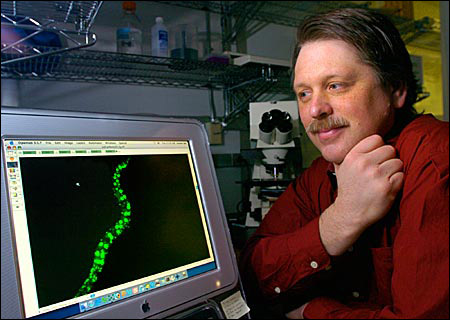A touch of elegans
Craig Hunter worms his way to new knowledge

Wondering why his relatives went bald stimulated an interest in genetics for Craig Hunter.
“When I was 10, I noticed that all of my mother’s uncles and male cousins were completely bald at age 30,” recalls the newly appointed professor of molecular and cellular biology. “I started wondering if I was going to be bald in another 20 years.”
Questions like that marked the dawning of a basic interest in heredity and genetics. But he was not intrigued enough with cutting up frogs or learning about body parts to be a biology buff in high school. It wasn’t until his sophomore year at the University of Oregon in Eugene that he took his first course in biology – molecular genetics.
“I really enjoyed it, it fit my interest in the general questions I had about living things,” remembers Hunter, now 42 and not yet bald. “I worked as a teaching assistant for the course in my junior and senior years, and found that I also enjoyed teaching genetics to others.”
As an undergraduate, he also met the love of his research life, a tiny roundworm known as Caenorhabditis elegans. It is a creature barely as long as a period on this page, made up of only 1,000 cells. But scientists know the past and future of every one these cells.
“It’s a simple system from which we can learn complex things,” Hunter says enthusiastically. “It helps us cracks the code of how animals are built, how they develop structurally from fertilization to adulthood.” What’s more, we can learn lessons from C. elegans about development in plants, elephants, mice, and even humans.
Following the worm
Hunter chose the University of Colorado, Boulder, for his graduate work because the school boasted two laboratories that used C. elegans to investigate developmental biology. He also met his future wife, Margaret Lynch, there. They enjoyed skiing and hiking and pursued biology together.
After earning a Ph.D. in 1990, Hunter did postdoctoral work at the University of California, San Francisco. In 1997, he joined Harvard’s Department of Molecular and Cellular Biology as an assistant professor. From there, Hunter rose to an associate professorship in 2001 and received tenure last year.
During this time, research on C. elegans burgeoned. It became the first animal to have its genome completely sequenced. Then geneticists discovered a quick and easy way to silence or turn off any of the worm’s genes by introducing a form of RNA with the same sequence as the target gene. Other researchers soon found that this technique, called RNA interference or RNAi, could be used with any organism – plants, lab rats, even human cells.
“This was an extremely exciting and powerful discovery,” Hunter notes.
There are a lot of terrible diseases caused by malfunctioning genes – cystic fibrosis, certain breast cancers, Down syndrome, muscular dystrophy, Huntington’s disease, sickle cell anemia – to name some of the worst. Think of what a medical boon it would be if a way existed to selectively knock out those genes.
Hundreds of millions of dollars are now being invested to find medical treatments based on this technique. “In laboratory models, gene silencing can knock down viruses and reverse genetic disease,” Hunter says.
There’s one big problem. If you want to silence a gene in, say, cancer cells, you have to get RNAi into every cell that has the troublesome gene. In C. elegans, that isn’t necessary, the RNAi naturally spreads to knock out the gene in all the worm’s tissues and organs.
Hunter and his colleagues have been working for the past four years on the problem of how C. elegans spreads RNAi to all its cells.
Amazingly, it can even spread the effect to the next generation. If that could be done with human cells, genetic diseases might be reversed. If Hunter and his colleagues can find out how C. elegans does what it does, a great breakthrough in basic biology could become a great breakthrough in reducing human suffering.
So far, he’s off to a good start. His laboratory team discovered a gene involved in creating a channel through which RNA can enter C. elegans cells. That gene holds the blueprints for a protein that makes a gate in the otherwise difficult-to-penetrate cell membrane or envelope. Even better, humans possess a similar protein. If Hunter can determine how that protein works and how to turn on its gene, he will have found the handle to open the gate.
Right now, he is trying to do this with mouse cells, which also possess the protein. This step takes his experiments on a long biological leap from a simple, exotic worm to a creature that has many genes in common with humans.
Joy of teaching
Meanwhile, Hunter also does the other professional thing that brings him joy – teaching. His resume includes long lists of postdoctoral fellows, graduate students, and undergraduates whom he has helped to understand genetics.
“Harvard students are fantastic,” he comments. “It’s fun to teach people who are so smart. They grasp things so quickly, it makes me feel like a better teacher than I am.”
Right now, Hunter is on paternity leave with his 6-month-old son, Jackson. He and his wife, a lecturer in biology at Tufts University, also have a 3-year-old daughter, Kelly.
At the same time, Harvard is reorganizing its curricula, a task in which Hunter is participating. “I hope to teach a new introductory course in genetics,” he says.
That would be fitting – having the opportunity to inspire others the way he was inspired.




